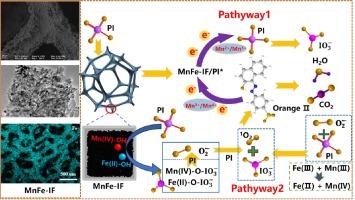多孔泡沫铁负载的锰铁作为高碘酸盐活化剂在污染物治理中的应用
IF 4.3
2区 工程技术
Q2 ENGINEERING, CHEMICAL
引用次数: 0
摘要
高效多孔催化剂的开发是实现有机污染物高效催化氧化的关键。为了提高高碘酸钾(PI)的活性,采用双氯水腐蚀法合成了泡沫铁负载的锰铁双金属催化剂(Mn-Fe-IF)。Mn-Fe-IF的独特形态和协同效应使其在降解各种有机污染物方面具有优异的活性和耐久性,超过了传统的非贵金属和先前报道的多孔催化剂。电化学评价、清除测试和电子自旋共振分析表明,电子传递机制驱动了Mn-Fe-IF/PI体系中的有机去除。催化剂激活PI,产生高潜力的中间体,显著增强污染物降解。此外,Fe(II)/Fe(III)和Mn(II)/Mn(III)/Mn(IV)的转化促进了单线态氧和超氧自由基在有机消除中的协同作用。这项工作为合成有效的多孔催化剂氧化有机污染物提供了新的见解。本文章由计算机程序翻译,如有差异,请以英文原文为准。


Manganese–iron supported on porous iron foam as efficient periodate activators toward pollutant abatement
The development of highly active porous catalysts is crucial for the efficient catalytic oxidation of organic pollutants. In this study, we synthesized a manganese–iron bimetallic catalyst supported on iron foam (MnFe-IF) using a dual chloride aqueous corrosion method to enhance potassium periodate (PI) activation. The unique morphology and synergistic effects of MnFe-IF led to exceptional activity and durability in degrading various organic pollutants, surpassing conventional non-precious metals and previously reported porous catalysts. Electrochemical evaluations, scavenging tests, and electron spin resonance analysis reveal that an electron transfer mechanism drives organic removal in the MnFe-IF/PI system. The catalyst activates PI, generating high-potential intermediates that significantly enhance pollutant degradation. Additionally, the transformation of Fe(II)/Fe(III) and Mn(II)/Mn(III)/Mn(IV) promotes the cooperative roles of singlet oxygen and superoxide radicals in organic elimination. This work provides new insights into the synthesis of effective porous catalysts for oxidizing organic contaminants.
求助全文
通过发布文献求助,成功后即可免费获取论文全文。
去求助
来源期刊

Chemical Engineering Science
工程技术-工程:化工
CiteScore
7.50
自引率
8.50%
发文量
1025
审稿时长
50 days
期刊介绍:
Chemical engineering enables the transformation of natural resources and energy into useful products for society. It draws on and applies natural sciences, mathematics and economics, and has developed fundamental engineering science that underpins the discipline.
Chemical Engineering Science (CES) has been publishing papers on the fundamentals of chemical engineering since 1951. CES is the platform where the most significant advances in the discipline have ever since been published. Chemical Engineering Science has accompanied and sustained chemical engineering through its development into the vibrant and broad scientific discipline it is today.
 求助内容:
求助内容: 应助结果提醒方式:
应助结果提醒方式:


